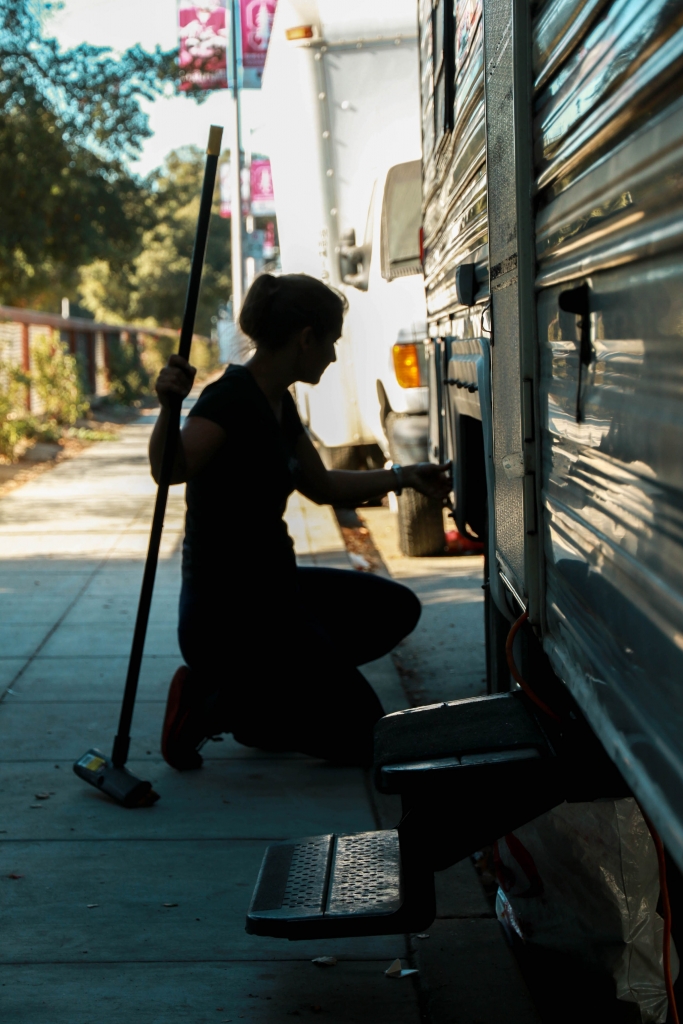Photos by LUCIA AMIEVA-WANG
EVERY 72 HOURS
RV LIFE ON EL CAMINO REAL
Every 72 hours, Britney and Niles pack up their things and get ready to move. Papers, clothes and books are stuffed into drawers, their belongings hastily tucked away. Every 72 hours, they lower the jacks and remove the wooden planks under the wheels of their RV. Every 72 hours, they turn off the generator, secure the propane gas tank, align the truck and call a U-Haul. Every 72 hours, they must find a new spot to park on the side of El Camino Real, because if not, a paper will be taped to the dashboard notifying the pair that their home will be towed away.
Directly across from the entrance to Palo Alto High School, dozens of RVs line the side of El Camino Real alongside Stanford University’s athletic fields. While for some, residing in RVs is a lifestyle choice, for many others it is their only way to live in an area as expensive as Palo Alto.
Though Paly students drive past these RVs every morning, community members send in complaints about the clutter and local newspapers write about the growing number of vehicles, but few know the names and stories of those affected by the housing crisis.
In this photo essay, Verde seeks to capture the raw realities and fundamental humanity of the people in our community living on El Camino Real — people like Britney, Ty and Arturo, whose last names have been omitted due to privacy concerns.
BRITNEY
VACATION TURNED LIFE – Every time a car zooms by on El Camino Real, Britney and Nile feel their home rock side to side. Living in a ’70s blue-and-maroon trailer with an easily excitable puppy, the young couple has faced quite a few struggles living in the Bay.
Britney came to California in the summer of 2014 on vacation, but ended up falling in love with the state, meeting Nile and staying. However, despite working three jobs back-to-back and splitting an apartment in South San Jose with two others, the couple found it nearly impossible to live a financially stable life. Investing in an RV, Britney explains, was their best option — it allows them to live in a safer area, find well-paying jobs and enjoy the Bay while they save up for their own place.
Most often, the police are called with complaints from the public about the look of the RV, but Britney views this as ironic.
“The public is going to call the police on these poor souls out here, who have nowhere else to go and who put a roof over their own head… so that their home gets towed,” Britney says. “What are they left with? They are out on the street, and that doesn’t solve the homeless problem.”
TY
ACROSS THE CAMINO – Ty, 22, still dressed in her pajamas, peeks her head out, squinting as her eyes adjust to the bright sun. “Even though it [the RV] is slowly breaking down every day, we are trying our hardest to get out of it.” Despite keeping to themselves, Ty and her partner have experienced a lot of harassment from the police, especially during the Stanford football season. Ty recalls one night, at 11 p.m., the police searched the vehicle. “They brought us out in our pajamas — we weren’t even allowed to put on our shoes,” Ty says. “They went through all of our cabinets and the reason they gave us was that the people parked previously there had run a meth lab out of their RV.”
ARTURO
MILES AWAY FROM HOME – Arturo holds the door open with his back as he climbs into his RV, carrying a bag of food from a nearby Mexican supermarket in one hand and a ripe cantaloupe in the other. It is a Tuesday – the second full day away from his wife and six kids who live in Fresno. Arturo drives three and a half hours every weekend to get to Palo Alto, where he is employed as a painter, while his family stays rooted in place. This week he is painting the office buildings at Stanford Medical School. “I started to meet people who were coming from the Bay to work,” Arturo says in his native Spanish. “Their salaries were double what I was making and that was my motivation for coming here.” The San Jose rent for sharing one room with three others was $1,200 a month, so Arturo began looking for other housing options. One Sunday, he and his eldest daughter went out and bought the $7,000 RV that is now parked on El Camino Real. Arturo and his wife initially wanted to move their family to Palo Alto but realized it was impossible after looking at the housing prices. “Take that yellow house right there,” Arturo says, pointing towards the corner of Churchill and El Camino. “Four million dollars. It’s very expensive. No one can buy. We could never.”



